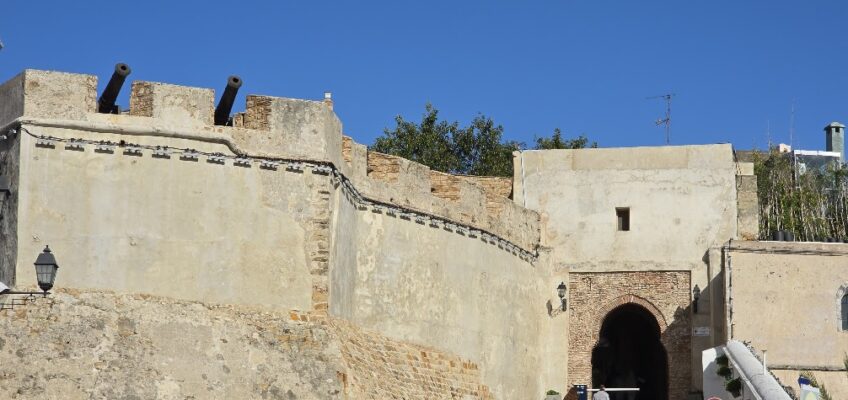I’ve already written about how surprising Morocco has been so far. Well Tangier was far and away the most surprising place we visited in northern Morocco.
Here’s my story. If you just want photos, my Northern Morocco album is now complete.
The drive from Chefchaouen
The drive from Chefchaouen to Tangier was through steady rain most of the way, so I didn’t see much out the van window. But we did get to see Ceuta, a Spanish exclave on the Mediterranean coast. Yes, part of Spain is in Africa.
A little farther along, we stopped for a look across the Strait of Gibraltar. We weren’t hopeful about being able to see it with the rain and fog, but as we stood gazing across the water, the clouds lifted, and lo and behold, there was the Rock!
Continuing toward Tangier, we passed by the enormous port of Tanger Med, the largest port in Africa and one of the largest industrial ports in the world. I had no idea how huge this port is. It felt like we were driving past it for hours!
After we did get to the other side of the port, it was still bit of a drive to Tangier, and during the drive the clouds dissipated and the skies turned blue, so we got some beautiful views of the western end of the Mediterranean.
Tangier
We did finally make it to Tangier, and after a stop for lunch, we picked up a local guide and drove to some interesting spots.
Malcolm Forbes purchased this property in 1970 and converted it to a museum with a collection of 115,000 toy soldiers reenacting major battles of history, from Waterloo to Dien Bien Phu.
The museum closed in the 1990s, after Forbes’ death. It is now owned by the government of Morocco and serves as a residence for official guests.
The medina and kasbah
Soon we arrived at the entrance to the medina (the photo at the top of the page is the gate leading into the kasbah). Just to clarify, the medina is the old city, and the kasbah is the fortress. In Tangier the medina is inside the kasbah. There is also a kasbah palace in Tangier, within the walled medina. It’s confusing, I know. In fact, I’m not sure if I’m explaining it correctly.
We walked through the medina, with our guide pointing out some interesting things. I had not realized that Tangier was part of an international zone for many years in the 20th century. During that time, a lot of Americans lived there. Many of the writers of the beat generation, such as Paul Bowles, William S. Burroughs, Jack Kerouac, and Allen Ginsberg lived there or spent extended periods visiting. Barbara Hutton, heir to the Woolworth fortune and wife to seven different men including Cary Grant, also had a house there, which she bought at auction, sight unseen.
The biggest surprise in the medina of Tangier is how safe it felt. Didn’t Tangier have a reputation for being very dangerous? Apparently, the current king, Mohammed VI, has made an effort to clean up many of the cities where tourists go, and Tangier was one of his projects. It felt safe, clean, and very accessible. The shops sold interesting items, similar to what I saw in Chefchaouen. No pickpockets, no kids begging, no suspicious-looking characters lurking about.
I really enjoyed our short visit to Tangier.
Jewish Cemetery
This morning, before we left, I visited the Jewish cemetery, Bet Hahayim. I was greeted almost immediately by the caretaker/guardian, a man whose name, I think, was Dody. He spoke French, and I did my best to conjure up my high school French to converse with him, but I am not confident that I understood everything he told me.
I did get that there are 4,000 graves in the cemetery, dating from the 1300s to 1983, after which the cemetery was closed to new burials.
I asked Dody what happens to him when he dies. He said he will go in a Moroccan cemetery. “Je suis marocain,” he said. “I am Moroccan.”
I’m happy to be in a Muslim/Arab country where Jews have been, for the most part, an integral part of the culture and a respected ethnic minority. Morocco is one of the few countries in the world that protected its Jews from the Nazis during World War II. Though the population of Jews in Morocco has decreased significantly since the founding of the State of Israel, Morocco currently has the largest Jewish community in the Arab world. Today Morocco officially recognizes Israeli statehood. In Casablanca there is a Museum of Moroccan Judaism, the only Jewish museum in any Arab country.
Olives
I also love that they have lots of olives here.
This wasn’t really a surprise, though. Just something I like about Morocco.
And now…
We took the high-speed train from Tangier to Rabat this afternoon, and the six of us on the pre-trip met the remaining eight with whom I’ll be traveling on the main trip. I’m looking forward to the explorations to come in the weeks ahead.


Joy Sherman
Lovely, all of it, and I have never seen such a variety of olives!